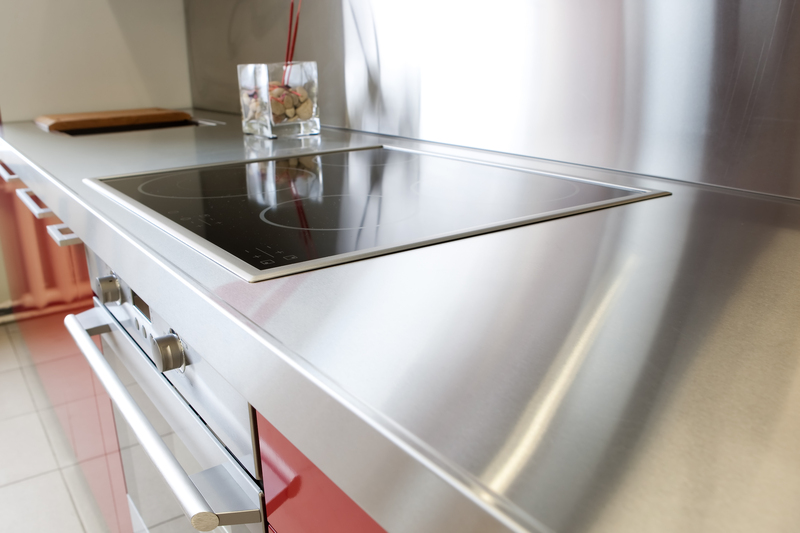Quick Tricks to Maintain a Mold-Free Bathroom
Posted on 03/06/2025
Quick Tricks to Maintain a Mold-Free Bathroom
Mold is one of the most persistent and unwelcome issues that can affect your bathroom space. Not only does it create unsightly stains and bad odors, but it can also negatively impact your health and the structural integrity of your home. The humid conditions in bathrooms are the perfect breeding ground for mold spores to thrive. Luckily, with a few easy-to-follow quick tricks, you can keep your bathroom fresh, clean, and free from mold. In this comprehensive guide, we'll walk you through the most effective ways to enjoy a mold-free bathroom.

Understanding Mold Growth in Bathrooms
Mold is a type of fungus that loves moist, warm, and poorly ventilated areas. Bathrooms often meet all these criteria, which makes them prime spots for mold to develop. Some underlying causes of mold in bathrooms include:
- Poor ventilation
- Constant humidity
- Leaks in plumbing or fixtures
- Leftover water on surfaces
- Infrequent cleaning
By addressing these triggers head on, you'll be on your way to maintaining a clean, healthy, mold-resistant bathroom.
Why Is Mold Dangerous?
Mold exposure can cause a range of health issues, especially for those with allergies, asthma, or compromised immune systems. Even healthy individuals may experience symptoms such as:
- Eye, nose, and throat irritation
- Coughing or wheezing
- Skin rashes and headaches
- Worsened asthma symptoms
Beyond health risks, mold can damage bathroom tiles, grout, drywall, and even subflooring, leading to costly repairs. That's why it's vital to prevent and control bathroom mold effectively.
Your Ultimate Guide to Quick Tricks for a Mold-Free Bathroom
Ready to fight back against bathroom mold? Use these quick, actionable strategies to keep your bathroom in top shape:
1. Prioritize Ventilation for a Mold-Resistant Bathroom
Proper ventilation helps remove the heat and moisture that mold loves. Try the following:
- Run exhaust fans during and after showers or baths for at least 15-20 minutes.
- Open windows when possible to allow fresh air exchange, even just a few minutes daily helps.
- If you don't have an exhaust fan, consider installing one or using a portable fan.
- Keep doors slightly ajar when the bathroom isn't in use to promote airflow.
2. Control Humidity Levels
Humidity is the main culprit in keeping bathrooms mold-friendly. To create a hostile environment for mold spores:
- Use a dehumidifier if your bathroom remains damp.
- Monitor humidity levels with a hygrometer; aim for below 50% humidity.
- Wipe down wet surfaces such as shower walls, mirrors, and countertops after use, using a squeegee or absorbent cloth.
3. Clean Regularly with Mold-Preventing Solutions
Good cleaning habits are essential to prevent any mold spores from gaining a foothold:
- Scrub tiles and grout weekly with an anti-mold cleaner or a homemade mix of vinegar and water.
- Sanitize shower curtains by machine washing them monthly. Choose mildew-resistant liners whenever possible.
- Don't forget to clean hard-to-reach spots like behind the toilet, under sinks, and inside storage units.
- Use a toothbrush to get into small crevices where mold can hide.
4. Remove Bathroom Clutter
Clutter in bathrooms--such as unnecessary bottles, sponges, or loofahs--traps moisture and provides more surfaces for mold to develop. Keep your shelves, counters, and shower clear by:
- Limiting personal care products to just the essentials.
- Regularly washing or replacing bathroom accessories like sponges and towels.
- Storing items in well-ventilated cabinets instead of leaving them on damp surfaces.
5. Address Leaks Immediately for Mold-Control Success
Leaky showers, faucets, and toilets can keep surfaces continually wet, which is a paradise for mold. Check regularly for leaks and fix them as soon as you spot them. Don't forget to inspect:
- Under sinks and behind toilets
- Showerheads and bathtub spouts
- Pipes and connection joints
- Grout lines and caulk for cracks
Promptly sealing leaks not only maintains a mold-free bathroom but also helps conserve water and reduce utility bills!
6. Use Mold-Resistant Materials and Paints
Newer bathrooms often use materials specifically designed to combat mold growth.
- Mildew-resistant shower curtains and liners resist moisture buildup.
- Mold-inhibiting paints protect ceiling and wall surfaces.
- Consider upgrading to non-porous tiles, glass, or solid surfaces that minimize water penetration.
7. Keep Surfaces Dry Whenever Possible
Mold needs moisture to survive. Making it a habit to wipe down bathroom surfaces daily can dramatically reduce mold risk.
- Squeegee shower stalls and bathtubs after use.
- Dry sinks and counters after washing hands or brushing teeth.
- Air-dry towels and bathmats by hanging them on bars rather than hooks.
8. Check and Replace Old Grout and Caulking
Cracked or discolored grout and caulk are signs that moisture can seep in behind tiles, where mold loves to grow unseen. Inspect and reseal tile joints every 1-2 years or whenever you notice signs of wear.
- Remove old, damaged grout and reapply waterproof grout or caulk specifically designed for bathrooms.
- Check around tubs, showers, and sinks for gaps or cracks.
9. Wash Bathroom Textiles Frequently
Shower curtains, bathmats, and towels are common mold magnets. It's crucial to wash these textiles in hot water at least weekly.
- Choose quick-drying fabrics and avoid leaving damp textiles in piles.
- Hang items to dry fully between uses.
10. Try Natural Mold Fighters
If you prefer chemical-free options, there are several natural substances that help keep bathrooms mold-free:
- White vinegar: Effectively kills most types of mold on contact.
- Baking soda: Acts as a gentle abrasive and deodorizer.
- Tea tree oil: Has natural antifungal properties (mix with water as a spray).
Regularly cleaning with these ingredients can offer ongoing protection for your bathroom surfaces.
Bonus Tips for Ongoing Mold Prevention
Consistency is key when it comes to achieving and maintaining a mold-free bathroom. Here are a few extra quick tricks you might not have considered:
- Keep the shower door or curtain open after use to let air circulate.
- Avoid leaving wet towels or clothes on the floor or in hampers for more than a day.
- Invest in moisture-absorbing products such as silica gel or activated charcoal for cabinets and closets.
- Educate family members about these tricks so everyone does their part.
Signs That You May Already Have a Mold Issue
Spotting mold early can save you time and money. Here's what to look for:
- Musty or earthy smell lingering in the bathroom
- Dark patches or spots on walls, ceilings, grout, or caulking
- Peeling paint or bubbling wallpaper
- Unusual allergy or respiratory symptoms when in the bathroom
If you detect any of these warning signs, take immediate action using the quick tricks above, or seek help from a mold remediation specialist for severe infestations.

Frequently Asked Questions About Bathroom Mold Prevention
How often should I clean my bathroom to prevent mold?
Aim to clean your bathroom once a week with special attention to damp areas such as showers, tubs, and sinks. Quick daily wipe-downs of wet surfaces will also make a big difference.
What's the best cleaner to use for bathroom mold?
Mix equal parts white vinegar and water in a spray bottle for a powerful and natural mold-fighting solution. Commercial anti-mold cleaners can also be very effective.
Is mold always visible?
No, mold can hide behind walls, tiles, or under floorboards. Address leaks, musty smells, and maintain diligent cleaning routines to reduce the chance of hidden mold spreading undetected.
Should I repaint my bathroom if I had mold before?
If you've had mold issues, remove existing mold thoroughly and opt for a mold-resistant bathroom paint to reduce the chance of recurrence. Always repair leaks and seal surfaces before repainting.
Conclusion: Enjoy a Healthy, Mold-Free Bathroom with These Quick Tips
Maintaining a mold-free bathroom doesn't have to be a daunting task. By implementing these quick tricks--from improving ventilation and lowering humidity levels to regular cleaning and prompt leak repair--you'll ensure your bathroom becomes and remains a fresh, healthy space for years to come. Make these maintenance actions a habit, and your home will thank you with sparkling, mold-resistant bathrooms everyone will appreciate.
This guide is designed to provide you with actionable, evidence-based advice to keep every corner of your bathroom clean and free from mold, no matter the season. Start today and enjoy a healthier home tomorrow!





